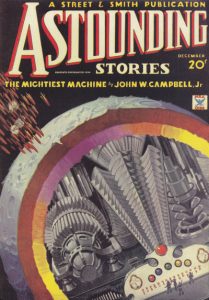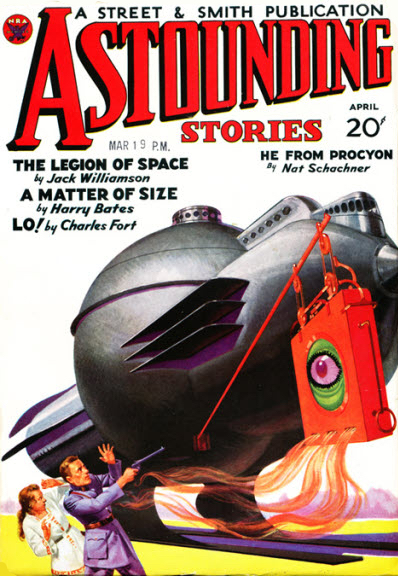 Like Hugo Gernsback had done before it, the demise of Astounding Stories was short-lived. Sold to Street & Smith, the powerhouse publisher of The Shadow, Wild West Weekly, Love Story Magazine, and other pulps, the magazine was back on the racks in September 1933. The new Astounding Stories was edited by F. Orlin Tremaine who seemed to have great faith in the future of science fiction.
Like Hugo Gernsback had done before it, the demise of Astounding Stories was short-lived. Sold to Street & Smith, the powerhouse publisher of The Shadow, Wild West Weekly, Love Story Magazine, and other pulps, the magazine was back on the racks in September 1933. The new Astounding Stories was edited by F. Orlin Tremaine who seemed to have great faith in the future of science fiction.
Mirroring Harry Bate’s ability to offer more money to his writers and pay rapidly, Tremaine worked to improve the literary quality of the fiction that he published. He challenged his writers to think outside the box, asking them to explore new ideas through what he called “thought variant” stories. Aided by his assistant editors, Desmond Hall and, later, John W. Campbell, Tremaine hoped to diminish the literary bias against science fiction by publishing unusual works by the best science-fiction writers of the 1930s—Campbell, L. Sprague DeCamp, Raymond Z. Gallun, Murray Leinster, Frank Belknap Long, H. P. Lovecraft, C. L. Moore, Ross Rocklynne, Eric Frank Russell, Nat Schachner, E. E. Smith, Don A. Stuart, John Taine, Donald Wandrei, Stanley G. Weinbaum, Jack Williamson, and others.
After publishing such classic works of science fiction as John W. Campbell’s “The Mightiest Machine,” Raymond Z. Gallun’s “Old Faithful,” Murray Leinster’s “Sidewise in Time,” H. P. Lovecraft’s “At the Mountains of Madness” and “The Colour Out of Time,” E. E. Smith’s “The Skylark of Valeron” and “Galactic Patrol,” Don A. Stuart’s “Twilight,” ” Stanley Weinbaum’s “The Red Peri,” and Jack Williamson’s “The Legion of Space,” Tremaine became an editorial director at Street & Smith. Although the best years of the magazine were yet to come, Tremaine had transformed Astounding Stories into the leading magazine in the science-fiction field. There it would stay for at least the next three decades.
To learn more about the image used in this post, click on the illustrations. Click here for references consulted for this article.







